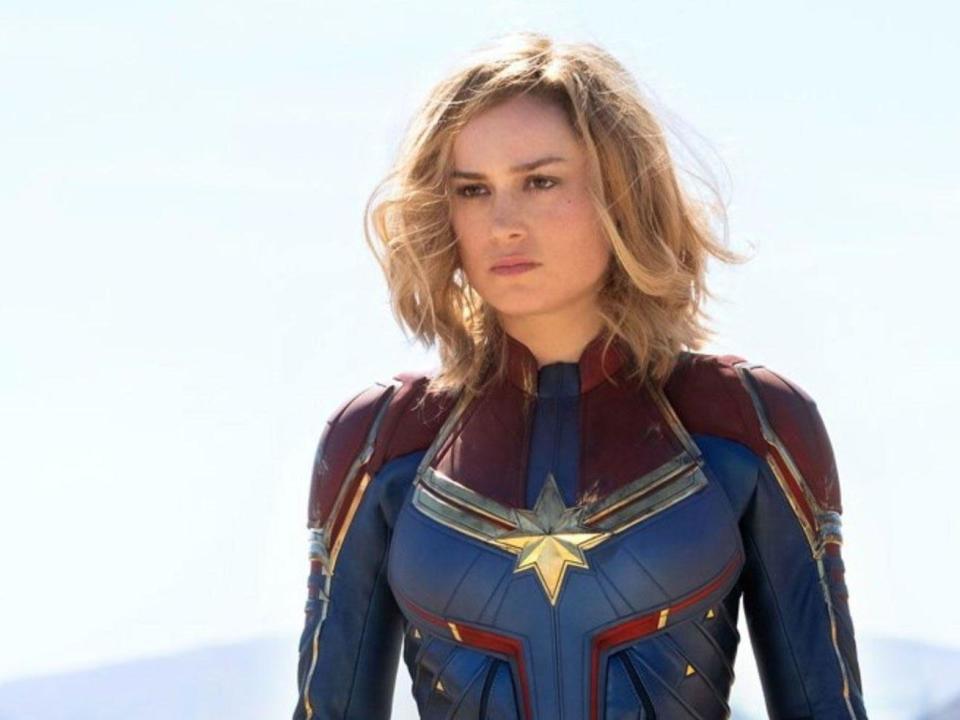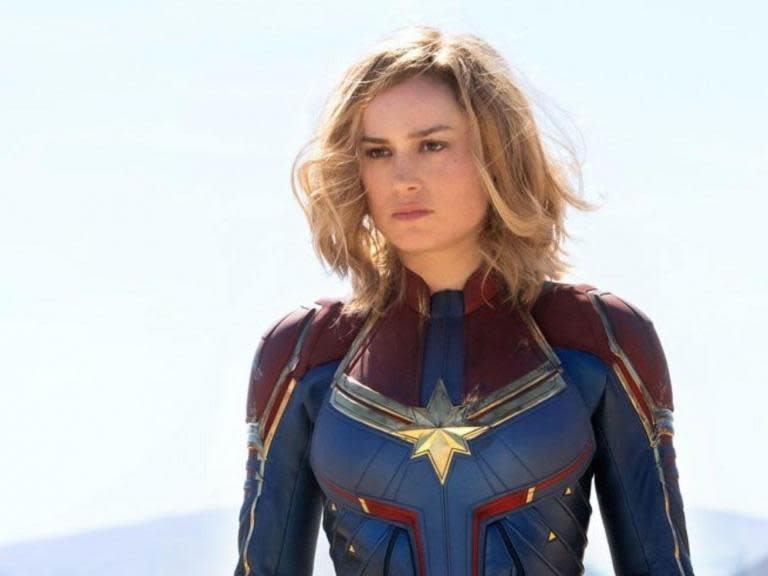Captain Marvel review: Brie Larson makes an engaging and witty superhero in new MCU film
Dir: Ryan Fleck, Anna Boden; Starring: Brie Larson, Jude Law, Samuel L Jackson, Annette Bening. Cert 12A, 124 mins
The late Stan Lee makes one of his final blink-or-you’ll-miss-him cameos in Captain Marvel, the most recent of the superhero films his comic book Marvel empire has helped usher into existence. This is a blockbuster that has its tongue firmly in its cheek. It has a Back to the Future-style plotline with a welcome feminist slant. The gags and the stunts keep pace with one another.
The biggest challenge facing its star Brie Larson’s Carol Danvers/Captain Marvel isn’t taking on her galactic enemies or puzzling out just where she comes from. It is making sure she isn’t upstaged by her wily, scene-stealing co-star, Samuel L Jackson. Larson, an Oscar winner for Room, also has to compete for audience attention with one of the more lovable cats to have appeared on screen in recent years. It’s a measure of Larson’s energy and charisma that she eventually puts both Jackson and her feline competition in their place. The film itself doesn’t glow in the same way as Larson does. There aren’t many ideas here that haven’t already been explored in all those other movies from the Stan Lee stable that have dominated the global box office in recent years
Larson’s character is first met here on the planet Hala as a member of the Starforce, a crack unit of “Kree” special forces soldiers. She is under the command (and mentorship) of Yon-Rogg (Jude Law). Vers, as the Kree call her, has formidable powers which she herself doesn’t fully know yet how to harness. She struggles with her emotions and with her past. The filmmakers include flashbacks to a mysterious crash in which she appears to have been involved and of a killer appearing out of the smoke like one of those deadly assassins in Sergio Leone spaghetti westerns. There are also scenes of her childhood and early adulthood when she is continually having to pick herself up after being bullied and humiliated by the menfolk in her life.
Vers is somehow linked to a female scientist, Dr Lawson, who had been busy designing a light speed engine. The Krees’ enemies, a race of pointy-eared Vulcan lookalikes called the Skrulls, are desperate to get hold of this engine.
All this information is difficult to process. What makes the film even more confusing is that the Skrulls, “insidious shape shifters”, can take over the bodies of anyone they meet. The Krees regard the Skrulls as terrorists and vermin and are trying to hunt them down across the universe. The Skrulls are led by Talos (Ben Mendelsohn, doing nothing to conceal his Aussie accent), who is ruthless and cunning.
The tone of the storytelling changes dramatically the moment Vers comes tumbling out of the sky and lands on a scruffy little planet which turns out to be Earth. It’s 1995 and her fall is broken by the roof of a local Blockbusters video store somewhere in Los Angeles. It’s at this point the in-jokes begin to clog up the film. References to grunge, Leonard Cohen, the Fonz and Baywatch are all thrown in the mix. We see Larson as a Top Gun-like US airforce pilot in the late 1980s when she is called Carol Danvers.
Scenes involving Larson and Samuel L Jackson (as young SHIELD agent Nick Fury) play like something out of one of the Lethal Weapon capers from the period. The difference is that Larson is a woman and turns the usual sexist buddy movie conventions on their head. She and Jackson have an effective comic rapport, joshing away with each other between (and sometimes during) the many action sequences.
Directors Anna Boden and Ryan Fleck, who made their reputation with indie films such as Half Nelson and, more recently, Mississippi Grind, ensure that Captain Marvel never takes itself too seriously. At the most solemn and dramatic moments, there will always be a piece of comic business involving the pet cat. There are jokes about creaky, slow-loading 1990s computer technology and affectionate homages to The Right Stuff.
Larson’s character may have anger management issues and unresolved questions about her past but she is a relentless optimist. The film rarely delves too far into the darker areas of her psyche. Nor are there any romantic subplots. The Krees and Skrulls are too busy fighting each other for the filmmakers to have time to look inward. The screenplay touches on the plight of galactic refugees, taking on other people’s identities as they look for a planet on which they can safely live, but there aren’t too many direct references to anything happening now in Trump’s America.
The best moments here tend to be the most old-fashioned and Earthbound ones. For example, a tremendous chase sequence on a Californian commuter train easily matches anything that happens in outer space. We see Larson clinging to the back of the train and balancing precariously on its roof in just the way a silent movie star might have done. She wends her way through the train’s carriages, never knowing what shape her enemy might have taken or whether she is about to be attacked by a mild-mannered businessman or a little old lady with Bruce Lee-like martial arts skills.
Captain Marvel is enjoyable enough as popcorn entertainment. You can’t help but admire the dextrous way the filmmakers fit the movie and its many protagonists within the Marvel cinematic universe or the humour with which they take us back to the 1990s. Larson makes a thoroughly engaging superhero, witty, courageous and with a sensitivity you don’t always find in characters trying to save the world. The film, though, is one dimensional. It’s the 21st entry in a cycle that began with Iron Man in 2008 and signs of rust are now beginning to appear.

 Yahoo Movies
Yahoo Movies 

